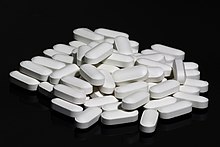User:Mr. Ibrahem/Calcium supplement
 500 milligram calcium supplements made from calcium carbonate | |
| Clinical data | |
|---|---|
| Trade names | Alka-Mints, Calcet, Tums, others |
| AHFS/Drugs.com | Monograph |
| License data | |
| Pregnancy category |
|
| Routes of administration | by mouth, intravenous |
Calcium supplements are salts of calcium used in a number of conditions.[2] Supplementation is generally only required when there is not enough calcium in the diet.[3][4] By mouth they are used to treat and prevent low blood calcium, osteoporosis, and rickets.[2] By injection into a vein they are used for low blood calcium that is resulting in muscle spasms and for high blood potassium or magnesium toxicity.[3][5]
Common side effects include constipation and nausea.[2] When taken by mouth high blood calcium is uncommon.[2] Calcium supplements, unlike calcium from dietary sources, appear to increase the risk of kidney stones.[2] Adults generally require about a gram of calcium a day.[2] Calcium is particularly important for bones, muscles, and nerves.[2]
The medical use of calcium supplements began in the 19th century.[6] It is on the World Health Organization's List of Essential Medicines.[7] They are available as generic medication.[4] The wholesale cost in the developing world is about US$0.92–4.76 per month.[8] In the United States treatment generally costs less than $25 per month.[5] In 2017, it was the 262nd most commonly prescribed medication in the United States, with more than one million prescriptions.[9][10] Versions are also sold together with vitamin D.[4] The combination, calcium/cholecalciferol was the 236th most commonly prescribed medication in the United States, with more than two million prescriptions.[9][11]
References[edit]
- ^ "WHOCC - ATC/DDD Index". www.whocc.no. Retrieved 12 September 2020.
- ^ a b c d e f g "Calcium Salts". The American Society of Health-System Pharmacists. Archived from the original on 18 January 2017. Retrieved 8 January 2017.
- ^ a b World Health Organization (2009). Stuart MC, Kouimtzi M, Hill SR (eds.). WHO Model Formulary 2008. World Health Organization. p. 497. hdl:10665/44053. ISBN 9789241547659.
- ^ a b c British national formulary : BNF 69 (69 ed.). British Medical Association. 2015. pp. 694, 703. ISBN 9780857111562.
- ^ a b Hamilton, Richart (2015). Tarascon Pocket Pharmacopoeia 2015 Deluxe Lab-Coat Edition. Jones & Bartlett Learning. pp. 215–216. ISBN 9781284057560.
- ^ Tegethoff, F. Wolfgang (2012). Calcium Carbonate: From the Cretaceous Period into the 21st Century. Birkhäuser. p. 308. ISBN 9783034882453. Archived from the original on 16 January 2017.
- ^ World Health Organization (2019). World Health Organization model list of essential medicines: 21st list 2019. Geneva: World Health Organization. hdl:10665/325771. WHO/MVP/EMP/IAU/2019.06. License: CC BY-NC-SA 3.0 IGO.
- ^ "Calcium Lactate". International Drug Price Indicator Guide. Archived from the original on 11 May 2017. Retrieved 8 December 2016.
- ^ a b "The Top 300 of 2020". ClinCalc. Retrieved 11 April 2020.
- ^ "Calcium - Drug Usage Statistics". ClinCalc. Retrieved 11 April 2020.
- ^ "Calcium; Cholecalciferol - Drug Usage Statistics". ClinCalc. Retrieved 11 April 2020.
